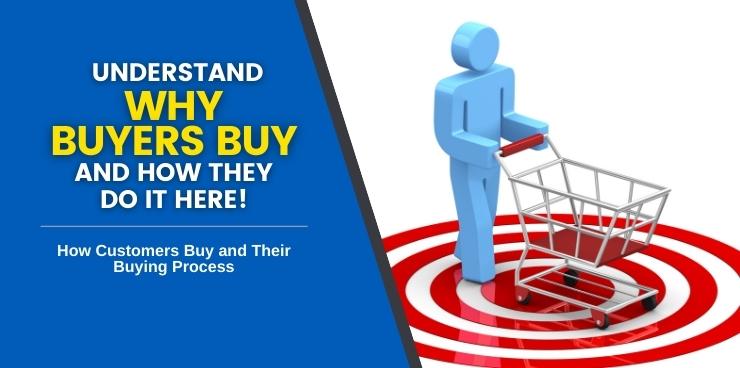The buying process involves all the steps that consumers take to make a purchasing decision. Recognizing the buying process helps your business understand your customers better. You can then use this information to improve your sales and marketing strategies at every touchpoint, ultimately increasing sales.
However, businesses sometimes focus too much on the buying process itself, not on why customers buy. Customer psychology is the process of buyers sifting through various solutions to find the best one and discard the others.
Understanding both the buying process and customer decision-making process are equally important to craft the best offer.
Because, and this might come as a shock, the sales process is not about your product nor your business. It’s about the customers. Unless a buying process becomes customer-oriented, it is less likely a business will succeed in the competitive landscape.
Here, we’ll discover how exactly the buying process works and uncover how consumers make purchasing decisions. Keep reading.
Sales Are Not About You nor The Product
Before delving into the buying process, it’s necessary to shatter some deep-seated beliefs that many subscribe to.
Every product and service possess a variety of features and perks that make them desirable, unique, and special. That’s true, but it’s not the features customers are looking for.
Many experts believe that consumers want the benefits they can get from the commodity. What customers really want are the advantages they can get from all the features and benefits your products and services offer.
How about the business, then? Why isn’t the buying process about my business when some people buy goods or services depending on the brand?
Remember that whatever you sell, no matter your value proposition and brand image, you’re only a means to an end.
Customers are after the advantages they can obtain from your solutions. It just so happens that your products and services give them that advantage. You also happen to be the one selling it, that’s why they choose you. It’s as simple as that. If you want to sell more, be the company that delivers empathetic competent convenience.
Embracing customer psychology is about taking the focus away from you and your business, then shifting it to your customers. Your solutions are only as good as their ability to provide your clients with the advantage they crave deep down.
Fully understanding the buying process begins with reframing your attention to what customers truly care about. Only then can you objectively improve your strategy and be more effective in a competitive marketplace.
If you need help in streamlining your buying process while improving your brand image, Wizard of Sales® can help you. Book a call.
Understanding How Customers Buy
Let’s take a look at how the buying process works. It’s essential to recognize that a buyer’s process exists before a customer makes the purchase. More often than not, your customers don’t have any knowledge of your business. What you do on their first encounter with you will determine the final action, whether to purchase or not.
The buying process begins and ends with the customer. It stems from two motivational drivers:
- Customers encounter and want to relieve a pain point
- Customers realize and desire to elicit a pleasure point
For example, someone with a broken air conditioner wants to feel the relief of cool air again. Their pain point is the stress that the discomfort brings them, the money and time they have to spend unwillingly, and possibly the frustration of the sales process. The pleasure points they are chasing are enjoying the comfort of cool air again, making a burden go away for good, and the satisfaction of knowing they went with the right service provider.
These underlying motivations kickstart the buying process. Your job is to show them that you have a solution that can help them get back to a baseline of happy.
The Buying Process
From the point when customers understand their needs, the buying process goes through 6 basic steps until the sale. We’ll explain each stage of the buying process below:
- Unaware
The first stage is unaware. This means customers don’t have any idea about your business, what you do, and what solutions you offer. Think about it. How many times have you known who to buy from when an external event triggers a need? Exactly.
Only companies who have invested in branded advertising stand a chance of winning the ‘name game’ before the external event triggers a need.
Your customers go through the same phase. This is when they start looking up queries like “HVAC contractor near me” or “best roofing company + location.” They’re not quite sure who they’re looking for. They are just trying to select the right provider the first time.
- Aware
Whether your name comes up on a Google search or you’re running branded advertising, prospects become aware of you. However, that doesn’t mean you’re their top choice.
In other words, awareness sounds pretty much like “Okay, I know what you do now, but so what?“
Always remember that what you sell is a means to an end. They’re stepping stones to greater gratification.
- Interest
Now it gets a little more interesting. It’s like looking eye to eye with a person from across the room and they give you a little smile. They’re looking for a solution and desirable perks that come along with it, and you happen to give those.
They’re like “Okay, I see you, but I am not yet certain you’re the one I really need.”
Interest often occurs when they begin learning more about your solutions. It steadily grows as they compare you to alternatives and get excited about the prospect of working with you.
- Conviction
In this stage of the buying process, they want to believe you’re a reliable and trustworthy service provider. They have gone through the pros and cons and seen the reviews, and you rank at or near the top.
Of course, nobody wants to get buyer’s remorse. Buyers are making sure your business and solutions fit with their beliefs. Do you understand and care about their underlying felt needs? Can your solutions truly appeal to their pain and pleasure points?
At the end of all verification comes conviction, or sometimes called desire.
- Decision
This is the, “I’m buying” moment. They’re committed to letting down their defences enough to let you make a sales pitch. They believe you have what they need, and hope you will deliver the desired outcome.
The question is: how do they get it?
For residential home services, this is in the form of scheduling a sales call.
This is where sales reps have the opportunity to shine through. Good knowledge of customer psychology, understanding of temperaments, and execution of a 5-star buying experience come in handy.
- Action
The final stage of the buying process is them taking action, this can either be buying or rejecting your solutions.
Unless your salespeople have the right tools to effectively close a deal with customers, they may shatter the entire build-up. Conversely, when everything is in place, the sales process and closing ARCs go smoothly, then there’s no reason they should say no.
You want to make sure this part of the buying process is smooth like butter. Eliminate any remaining doubts in your prospect’s mind and close the deal.
 The Decision-makers
The Decision-makers
In many markets, it isn’t only homeowners who get to decide if you’re the best-fit business and solution for them. People can go through several approval processes before they seal the deal with you. Here’s a quick breakdown of the decision-making influencers.
- Users — These are the people who will directly use the product or service. They may not be necessarily involved in the decision, but their opinions or suggestions bear weight.
- Influencers — Often outside the organization. Although they won’t use the commodity per se they are reputable enough to have a say on the decision. This includes technical advisors, personalities or journalists.
- Deciders — They bear the final decisions but may gather information from other units to consolidate their absolute say.
- Approvers — These people are often management teams and budget holders that need to sign approvals. In my house, it’s my wife.
- Buyers — Normally the deciders themselves. They’re actively involved in the transaction and negotiation process. My son sometimes has this role.
- Gatekeepers — The link between deciders and other decision-making units. For example, personal assistants who relay information from one party to another. The information is only as good as how they were conveyed. We also see this from the ‘helpful’ friend or neighbour who spends most of their time being shitty.
How Customers Buy
Sales close when an alignment of values and beliefs between the seller and buyer takes place. If your business and your products boast the same offer the things a prospect desires, you get the sale. However, if you botch anywhere within the buying process, you could jeopardize the entire transaction.
With that said, here are the 5 steps on how customers buy:
1. They are looking for someone (business and salesperson) who they feel good about.
If you think the product or service is all that matters, you’re mistaken. Underneath the buying process, customers want a reliable entity they can trust and build relationships with. This is where empathetic competent convenience comes in. Once your business or salesperson puts up an off-putting demeanor, you can throw your sale out the window.
2. They quickly want to know you are competent in solving their problem.
All things being equal, customers want empathetic competent convenience. Sadly, this often comes at a price and some buyers (transactional shoppers vs relational buyers) may not want to pay for it. Whether you sell premium or discount services, never sacrifice competence.
3. When they believe you understand how to solve their problem, they want options.
Customers won’t bother asking for solutions from businesses they feel can not live up to their expectations. When you meet or exceed their expectations, they will be interested in your options.
4. They will agree to commit when they are confident in the value and correctness of the solution.
Does the prospect believe your proposed solution solves their perceived problem? Does your business deliver irresistible value and delight? Can you alleviate their underlying felt needs with competence and convenience? If so, it’s your sale to lose.
5. Then it’s up to you to deliver.
 The Path To Loyalty
The Path To Loyalty
A sale does not equal loyalty. Just because they committed to working with you doesn’t mean you’ve convinced them of your value.
The buying process is one piece of the bigger picture. There are still post-sale interactions you must make sure to protect and nurture. It only takes one disappointing buying experience for you to lose everything you’ve worked to build.
The customers who hired you need to feel they’ve made the right choice. This is where you deliver with all your promises, if not exceed their expectations. Solve their problems (the real ones, not the superficial ones), and overdeliver value incessantly.
“You will always win when the customer believes they won.” — Ryan Chute
Do this authentically with integrity and gratitude, and you will too.
The question is: Do you want to win?
Wizard of Sales® can help you lead your tribe to victory. Through an expert understanding of the buying process and customer psychology, rest assured your business is in good hands. Book a call.



 The Decision-makers
The Decision-makers The Path To Loyalty
The Path To Loyalty